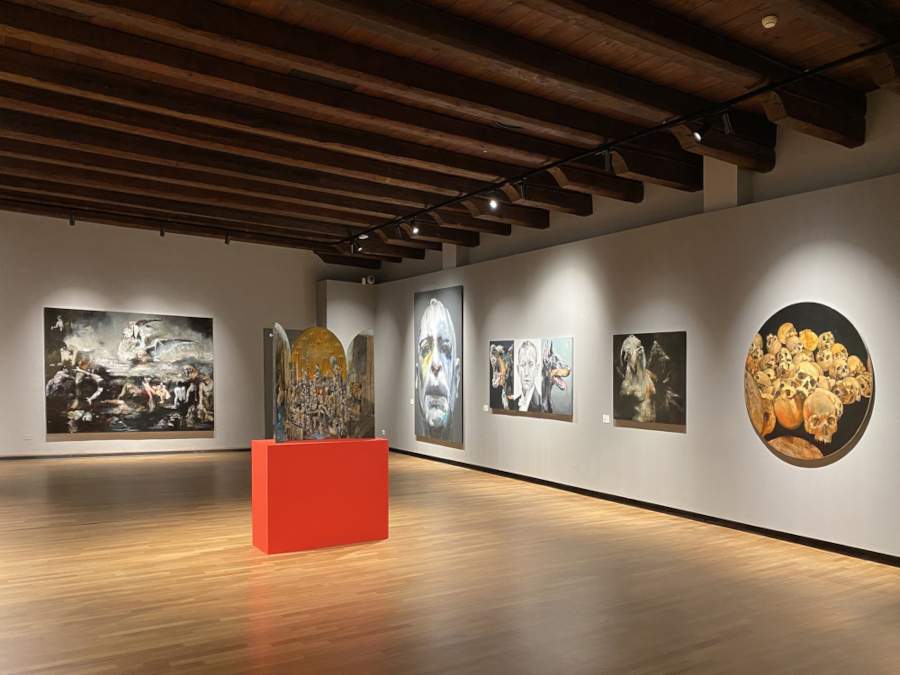Entitled A riveder le stelle (To See the Stars Again ), the contemporary art exhibition running until January 30, 2022 at the Museo degli Eremitani in Padua intends to ideally dialogue with Giotto ’s frescoes, which from July 2021 have been included in the UNESCO World Heritage List as Padova Urbs Picta. The exhibition, curated by Barbara Codogno and organized by the Cultural Department of the City of Padua in collaboration with The Bank Contemporary Art Collection with the support of the Fondazione Cassa di Risparmio di Padova e Rovigo, is designed to celebrate the 700th anniversary of the death of Dante Alighieri, but also to pay tribute to the author of the frescoes of the Scrovegni Chapel and the starry sky that can be admired inside. It is precisely the stars that are the greatest common point between Dante and Giotto: the starry vault of the Paduan Chapel and the stars invoked by Dante in the last verse of the Inferno, when he contemplates them together with Virgil, his guide.
The exhibition “does not want to be didactic,” explains the curator, “much less hagiographic or passatist, rather evocative and suggestive, while remaining faithful to the path of light traced by both Dante and Giotto and therefore ferrying the viewer to the relief of rebirth indicated by the stars.”
Thetribute to the two leading figures of the 14th century who revolutionized their era from an artistic and literary point of view is accomplished through approximately forty contemporary artworks from The Bank Contemporary Art Collection, some created especially for the exhibition occasion by Italian and internationally recognized figurative artists, which deal with the existential themes that Giotto frescoed in the Scrovegni Chapel and that Dante addressed in his Commedia. The artists presenting their works along the exhibition route, set up in the recently renovated rooms for temporary exhibitions at the Museo degli Eremitani, are Agostino Arrivabene, Saturno Buttò, Desiderio, Marco Fantini, Sergio Fiorentino, Giovanni Gasparro, Alfio Giurato, Federico Guida, Maurizio L’Altrella, Paolo Maggis, Vittorio Marella, Nicola Nannini, Sergio Padovani, Alessandro Papetti, Luca Pignatelli, Chiara Sorgato, Nicola Verlato and Santiago Ydáñez .
Theguiding image of the exhibition is the work by Sergio Padovani (Modena, 1972) entitled Open Stars, commissioned by The Bank Contemporary Art Collection: a painting that unfolds on an ascending scale evoking Dante’s three Cantiche. The narrative spiral movement, which recurs in both the Divine Comedy and the Scrovegni Chapel with particular reference to the fall, is evoked by the paintings of Nicola Verlato (Verona, 1965) and Giovanni Gasparro (Bari, 1983). Giotto’s cross dialogues with Federico Guida ’s La mia prima croce (Milan, 1969), while Nicola Nannini ’s (Bologna, 1972) work Si fece buio su tutta la terra (It became dark over all the earth ) was chosen to evoke the Last Judgment. The Dantean universe of Cerberus and the beasts lives again in the works by Maurizio L’Altrella (Milan, 1972), while the bestiality of the dog becomes political in the triptych by Santiago Ydáñez (Jaén, 1967). Lucifer is the protagonist of another work by L’Altrella, La bestia luminosa, but also of Saturno Buttò ’s ironic reinterpretation (Venice, 1957). Lust is the protagonist of Federico Guida’s Circus and Home! Sweet home! by Desiderio (Milan, 1978). The path of rebirth in the sign of light is represented by artists leading into the waiting zone of Limbo, such as Alfio Giurato (Catania, 1978), Luca Pignatelli (Milan, 1962) and Alessandro Papetti (Milan, 1958). The journey ends in a Paradise where Giotto’s blue is found in the absolute backgrounds of Sergio Fiorentino (Catania, 1973), with the Bodies resting together in an embrace that consoles and comforts.
A riveder le stelle is divided into sections that reference details from the frescoes of the Scrovegni Chapel, as conceived by the curator. It starts from the Dark Forest and leads to Paradise, through Hell and Purgatory. Some of the works present are impressive, such as Agostino Arrivabene’s Martyrium: a Saint Sebastian from whose skin capillary structures branch outward; Luca Pignatelli’sWarrior Hero made on a railroad tarpaulin draws on ancient statuary, and his is also the large ship Rex that accompanies visitors to the last section devoted to Paradise. Desiderio brought a pile of pigs to the room dedicated to vice, and indeed the omnivore is an animal that symbolizes vice, while Sergio Padovani’s works recall Bruegel’s universe with tiny figures immersed in surreal and disturbing scenarios.
More information can be found at www.padovamusei.it
The exhibition is open to the public Tuesday through Sunday from 9 a.m. to 7 p.m. Closed on non-holiday Mondays, Christmas, Boxing Day, New Year’s Day. Until January 6, 2022, free admission for residents of Padua and province and university students. The catalog is published by Antiga Edizioni with critical text by Barbara Codogno and an unpublished story by Gabriele Dadati.
 |
| Dante dialogues with Giotto at the Museo degli Eremitani in the sign of the contemporary |
Warning: the translation into English of the original Italian article was created using automatic tools. We undertake to review all articles, but we do not guarantee the total absence of inaccuracies in the translation due to the program. You can find the original by clicking on the ITA button. If you find any mistake,please contact us.